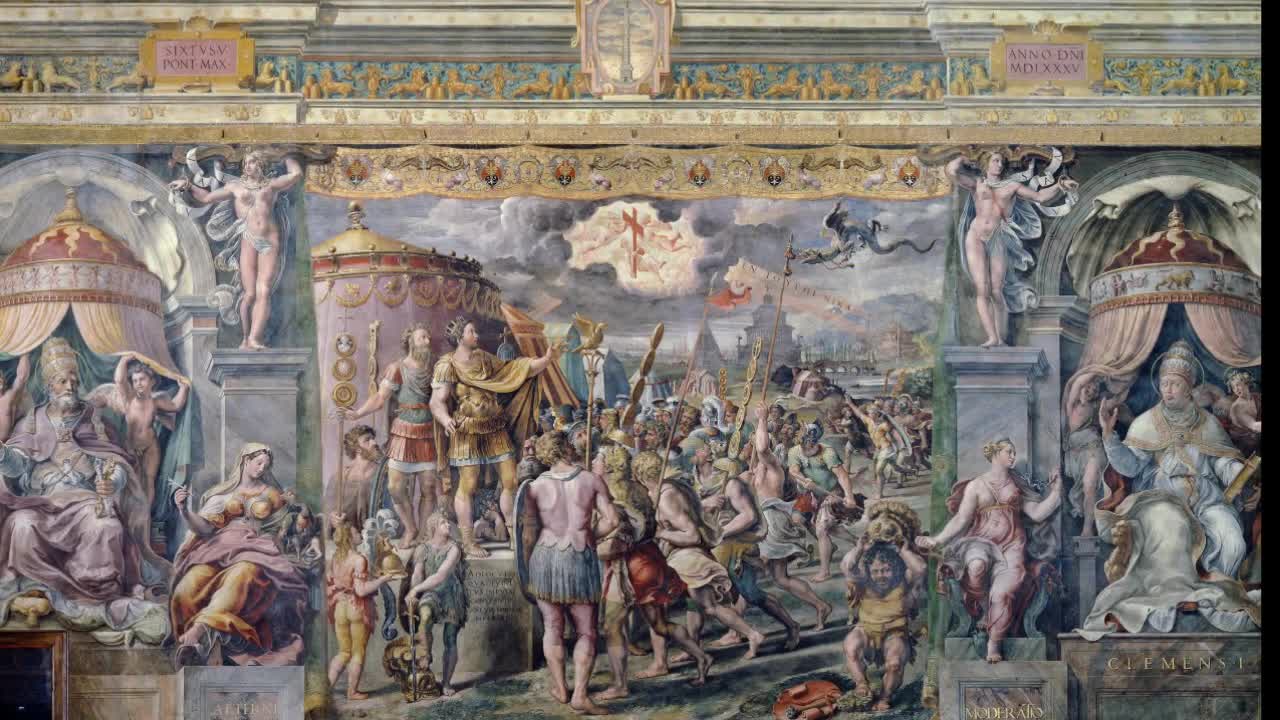Premium Only Content

#inspiration4: EN TOYTῼ NIKA ••• IN HOC + SIGNO VINCES - 27 Oct. 312 A.D.
#inspiration4: EN TOYTῼ NIKA ••• IN HOC + SIGNO VINCES - 27 Oct. 312 A.D.
https://www.zazzle.com/en_toyt%e1%bf%bc_nika_in_hoc_signo_vinces_canvas_print-192402192126223495
The Vision of the Cross is a painting made between 1520 and 1524 by assistants of the Italian renaissance artist Raphael. After the master's death in 1520, Gianfrancesco Penni, Giulio Romano and Raffaellino del Colle from Raphael's workshop worked together to finish the commission to decorate with frescoes the rooms that are now known as the Stanze di Raffaello, in the Apostolic Palace in the Vatican.
The Vision of the Cross is located in the Sala di Costantino ("Hall of Constantine"). In the painting, emperor Constantine I is seen just before the Battle of the Milvian Bridge on October 28, 312. According to legend, a cross appeared to Constantine in the sky, after which as seen in the fresco and following Eusebius of Caesarea Vita Constantini, he adopted the Greek motto "Εν τούτῳ νίκα", i.e. "By this, conquer", a motto that has been rendered in Latin as "In hoc signo vinces", i.e. "In this sign you shall conquer".
This Mannerist painting is a crowded and confused melee and melange of images, including a dragon, a dwarf, two popes, and various symbols. Proportions among the soldiers appear confused, with some dwarfed by more distant figures.
See the Vision of the Cross (detail) with the Meta Romuli and the Mausoleum of Hadrian in the background.
The Chi Rho is the symbol claimed in contemporary versions of the legend.
On the evening of October 27, 312 AD, with his army preparing for the Battle of the Milvian Bridge, the emperor Constantine I claimed to have had a vision which led him to believe he was fighting under the protection of the Christian God.
Lactantius states that, in the night before the battle, Constantine was commanded in a dream to "delineate the heavenly sign on the shields of his soldiers". Obeying this command, "he marked on their shields the letter X, with a perpendicular line drawn through it and turned round thus at the top, being the cipher of Christ". Having had their shields marked in this fashion, Constantine's troops readied themselves for battle.
From Eusebius, two accounts of a battle survive. The first, shorter one in the Ecclesiastical History leaves no doubt that God helped Constantine but does not mention any vision. In his later Life of Constantine, Eusebius gives a detailed account of a vision and stresses that he had heard the story from the emperor himself. According to this version, Constantine with his army was marching somewhere (Eusebius does not specify the actual location of the event, but it clearly is not in the camp at Rome) when he looked up to the sun and saw a cross of light above it, and with it the Greek words Ἐν Τούτῳ Νίκα. The traditionally employed Latin translation of the Greek is in hoc signo vinces— literally "In this sign, you will conquer." However, a direct translation from the original Greek text of Eusebius into English gives the phrase "By this, conquer!"
At first he was unsure of the meaning of the apparition, but the following night he had a dream in which Christ explained to him that he should use the sign against his enemies. Eusebius then continues to describe the labarum, the military standard used by Constantine in his later wars against Licinius, showing the Chi-Rho sign.
Those two accounts have been merged in popular notion into Constantine seeing the Chi-Rho sign on the evening before the battle. Both authors agree that the sign was not readily understandable as denoting Christ, which corresponds with the fact that there is no certain evidence of the use of the letters chi and rho as a Christian sign before Constantine. Its first appearance is on a Constantinian silver coin from c. 317, which proves that Constantine did use the sign at that time.He made extensive use of the Chi-Rho and the labarum later in the conflict with Licinius.
The vision has been interpreted in a solar context (e.g. as a solar halo phenomenon), which would have been reshaped to fit with the Christian beliefs of the later Constantine.
An alternate explanation of the intersecting celestial symbol has been advanced by George Latura, which claims that Plato's visible god in Timaeus is in fact the intersection of the Milky Way and the Zodiacal Light, a rare apparition important to pagan beliefs that Christian bishops reinvented as a Christian symbol.
#XP #Constantine #SPQR #IHSV #Adagio
-
 4:11
4:11
ProVaticanus
4 months agoNVMMVS: δ N FOCAS PЄR AVG ☩ VICTORI FOCAS AVG : CONOB #ProVaticanus
391 -
 0:15
0:15
Monkeypunch
4 years agoBobcat Oct 27 2020
88 -
 2:01
2:01
KTNV
4 years agoTasty Tuesday with Melinda Sheckells | Oct. 27, 2021
11 -
 1:00
1:00
KTNV
4 years agoFinancial Focus for Oct. 27, 2020
3 -
 1:04
1:04
My Home Videos
3 years ago $0.01 earnedTaneycomo Oct 2020
164 -
 15:46
15:46
KMGH
4 years agoTuesday, Oct. 27 East Troublesome Fire update
18 -
 3:41
3:41
One Way
4 years agoMatthew 18 | Weekday Word | Oct 27, 2020
39 -
 0:23
0:23
VideoLouisElovitz
3 years agoJO JO oct 2020- - "CALIFORNIA CATS"
114 -
 0:10
0:10
GroundhogX
4 years agoSquiggly on trailcam. Oct. 2020
39 -
 3:12
3:12
MysticKeith
4 years agoOct Nov Market Review
111